
Content curation is a great asset available for marketers to maximize the impact of social selling programs. Scoop.it recent integration with social selling solutions such as GaggleAMP, unleash the power of content curation + social selling. But why is curation such a nice tool to leverage employee advocacy? All the answers below, and also in our common webinar with GaggleAMP.
First, a quick reminder: social selling is all about using social media to generate relationships, leads, and eventually, sales. Here’s how LinkedIn’s Sales Solutions team defines it:
Social selling is about leveraging your social network to find the right prospects, build trusted relationships, and ultimately, achieve your sales goals.
The term has become more popular in recent years. Surprisingly, it’s actually more widely used than even the term “content curation”.
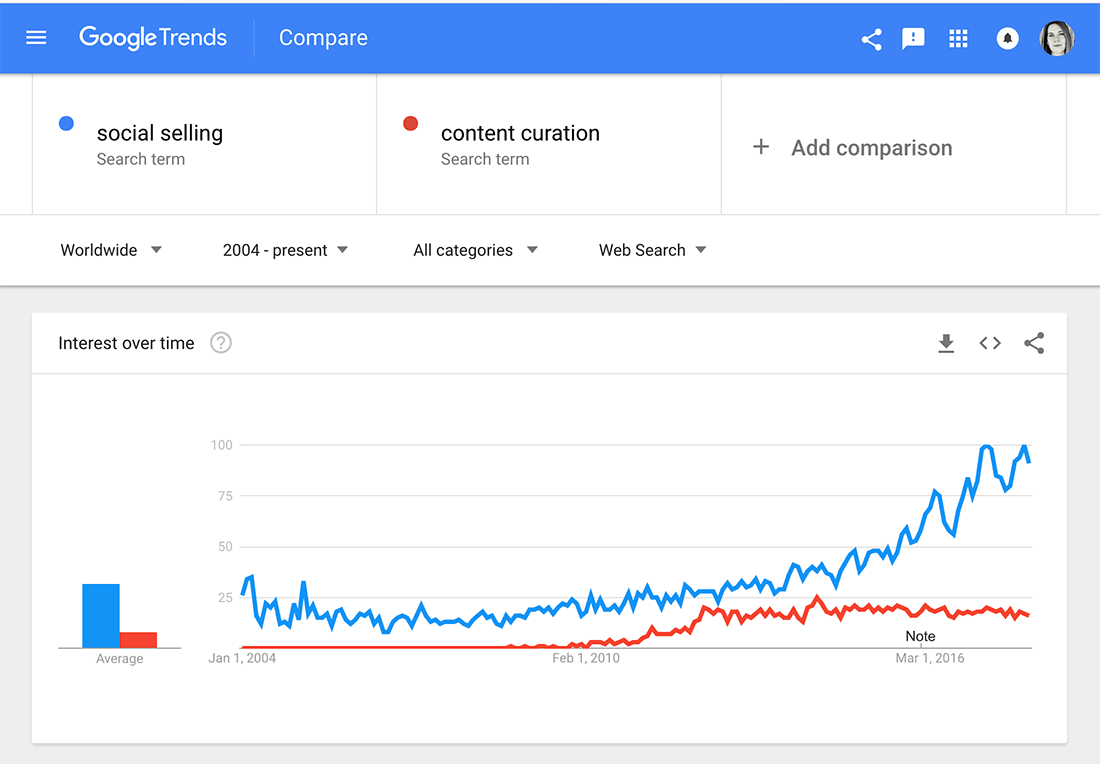 It’s interesting that content curation has gotten so much less attention than social selling, actually. The two tactics couldn’t be more complementary. Content curation for social selling just takes a good thing and makes it better.Here’s why:
It’s interesting that content curation has gotten so much less attention than social selling, actually. The two tactics couldn’t be more complementary. Content curation for social selling just takes a good thing and makes it better.Here’s why:
- Social selling is, at its core, a trust-building exercise.
So is content curation. And because they share the same goal, they are highly compatible strategies.
- The people who do social selling – entrepreneurs and salespeople – are connectors. They aren’t necessarily content creators, and they certainly aren’t full-time content creators.
There’s no way to keep up with the demands of a sales job and write a blog post every day, much less an ebook every month, and spin all that into videos,
email newsletters and images. You need outside help.And so, content curation to the rescue. Other people’s (aka “third party”) content can fill in the gaps in content that salespeople (or their content marketing teams) don’t have time to create in-house.
- Salespeople sell solutions now, not products.
And as a result, they need all the authority and expertise they can muster. This is why the best salespeople are experts in their fields.
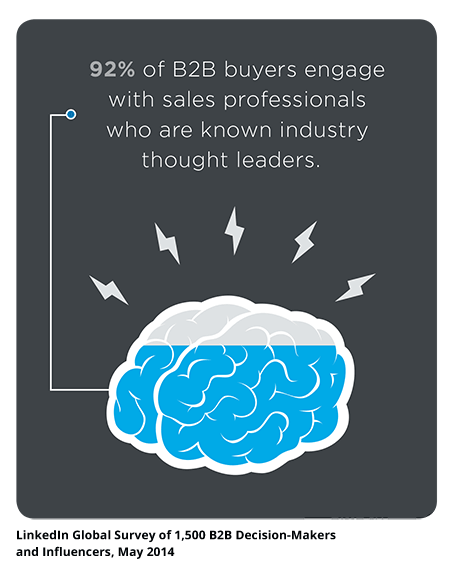 They know not only the products or services their own company sells – they also know exactly what buyers want and don’t want.If sales staff only shares in-house content, their authority takes a hit. They look like “that guy” at a party who only talks about himself. So they
They know not only the products or services their own company sells – they also know exactly what buyers want and don’t want.If sales staff only shares in-house content, their authority takes a hit. They look like “that guy” at a party who only talks about himself. So they
use third-party content to boost their authority. The more useful and actionable that content is, the better.
- The way a smart salesperson passes choice pieces of content along fits perfectly into the definition of a good content curator.
Curators have never been people who just grab every piece of content on a topic. They are not automated aggregators.Good curators – successful ones – carefully select and organize the content they share. They add their own commentary about the content, and put it in context. As
Steven Rosenbaum writes in his book, Curate This: “curation is the art of creating something new, coherant and meaningful out of an abundance of related information and ideas.”Salespeople can be ideal curators because they would never just pass on every piece of content (like an aggregator would). They carefully hand-select content that’s tailored to each company, each prospect, and that suits wherever that buyer is in the sales funnel. They can do this with more sensitivity than an automated content stream, or even a marketing automation system could.The best salespeople take all this even further. They personalize every piece of content they pass along to their prospects. They write personal notes – maybe highlight sections of the content. Maybe even re-phrase what their prospect said the last time they talked. This is true consultative selling.One side benefit to all this? It makes a salesperson’s job safer in an increasingly automated world. The very best curation done via social selling is a way for salespeople to demonstrate their value and uniqueness. They have an exceptionally effective – and human –
way to build trust and to prompt feedback. Both of which are at the core of building a relationship… and making a sale.
- By being a trusted source of information about a particular topic, the salesperson becomes the go-to person in that niche.
According to
research from LinkedIn, “92% of B2B buyers engage with sales professionals who are known industry thought leaders.”And
according to sales professionals, trust closes as many deals as proof of ROI.
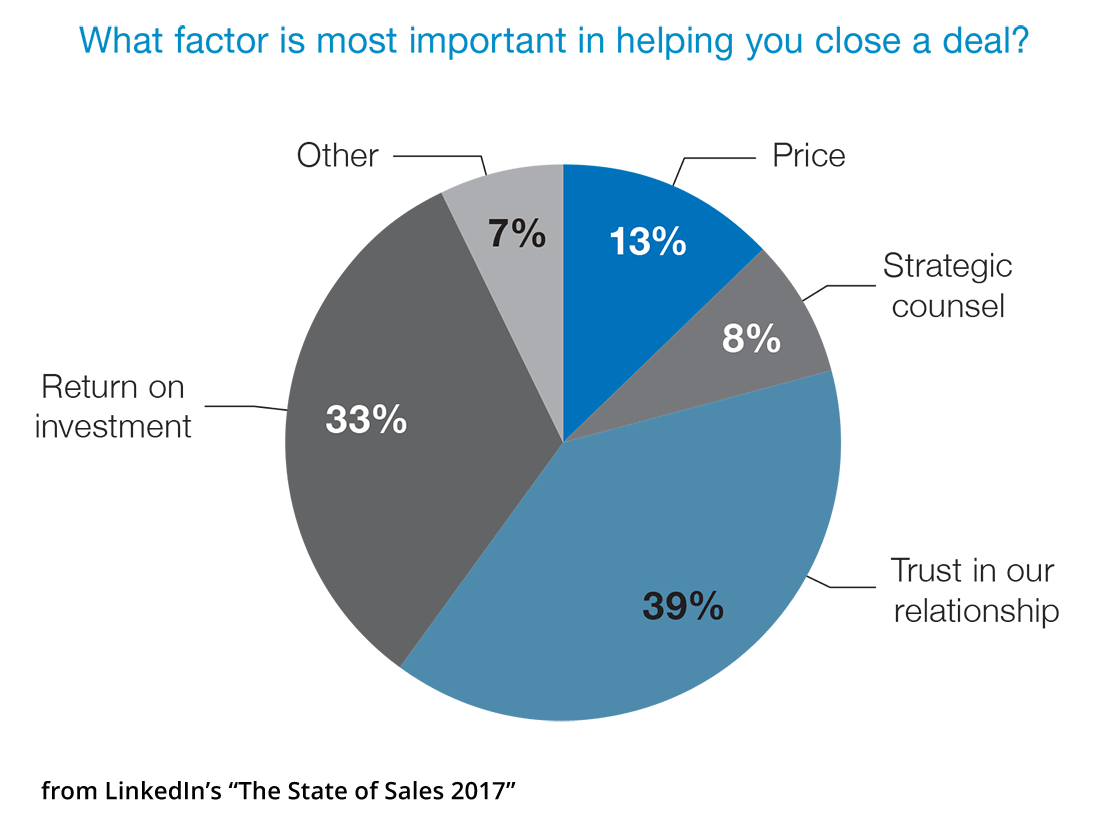 This idea of being “top of mind” has been the goal of advertisers for years. Staying top of mind = more sales. A steady stream of properly curated content can do that.Speaking of which…
This idea of being “top of mind” has been the goal of advertisers for years. Staying top of mind = more sales. A steady stream of properly curated content can do that.Speaking of which…
- Content curation is an ideal way to attract and nurture leads.
This point bridges the work of marketers and salespeople, but every salesperson I know has a list of warmish prospects they check in on from time to time.Often salespeople use curated content to incubate high-value prospects… even if it takes a year or more to bring them in.
- Offering third-party content (not just your own) builds trust. And trust – as we just saw above – sells.
There’s an old
study from the CMO Council that illustrates this well. They found that vendor-created content was trusted by only 9% buyers.That’s barely a sliver of goodwill compared to how much trust professional association research or analyst reports and white papers generated.
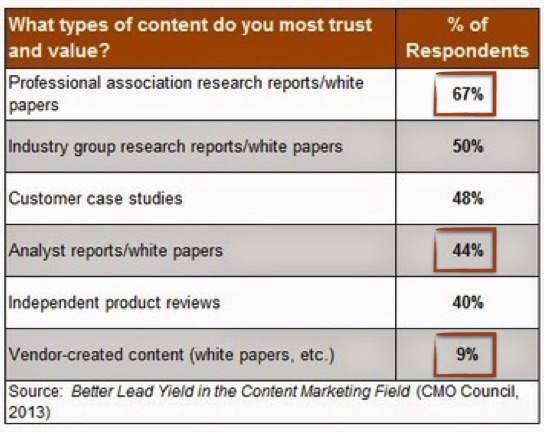 Key takeaway here? If you wanted to make a point (that you could use to close a sale with later), you’d be far better off forwarding association research or an independent analyst’s piece of content than your own company’s content. Your prospect trusts those sources more.
Key takeaway here? If you wanted to make a point (that you could use to close a sale with later), you’d be far better off forwarding association research or an independent analyst’s piece of content than your own company’s content. Your prospect trusts those sources more.
How to bring more content curation into your social selling.
Every salesperson knows to check in with their prospects on a regular basis. And there are plenty of good excuses for doing so:
- Because it’s been a month since you last spoke
- Because it’s their birthday
- Because they just launched a new product
- Because the salesperson has a new product
Those are all fine, but they’re pretenses. And everybody knows they’re pretenses.And everybody hates to be sold to.But the tone of the contacts change if you send along a piece of research that might actually help your prospect do their job.In fact, more than 90% of buyers say they are more likely to consider a brand’s products or services if their sales reps “share content applicable to my role in the decision-making process”.
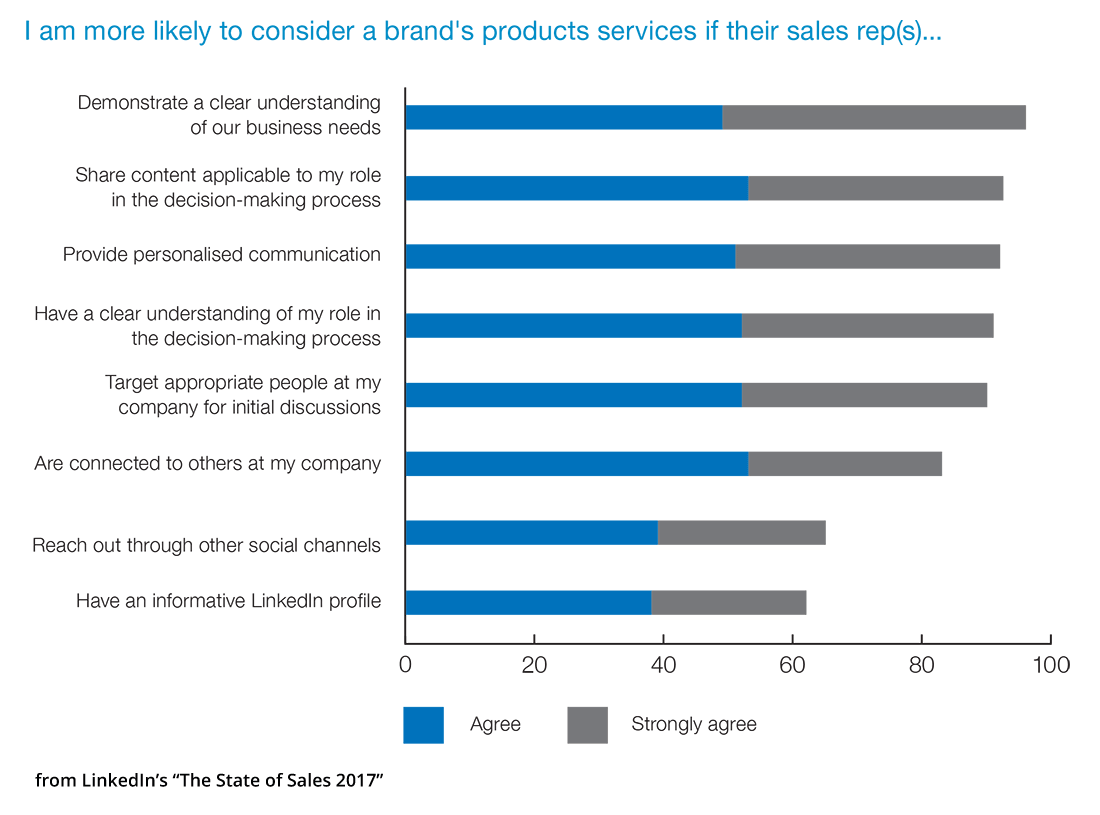 Buyers’ expectations have become so high that it isn’t even “going the extra mile” any more to give them highly relevant, useful information. It’s expected. LinkedIn reports that “64% of B2B decision-makers said they wouldn’t engage with a salesperson if the communication was not personalized.”Here’s an example of what this might look like: Send a prospect a copy of a well-known business book that your prospect has probably heard of, but might not have had time to read. And a personalized note to the package, and perhaps flag a chapter or two that you think they’d be particularly interested in.Voila! You’ve just done something about 20x more meaningful than leaving yet another message on their voicemail.
Buyers’ expectations have become so high that it isn’t even “going the extra mile” any more to give them highly relevant, useful information. It’s expected. LinkedIn reports that “64% of B2B decision-makers said they wouldn’t engage with a salesperson if the communication was not personalized.”Here’s an example of what this might look like: Send a prospect a copy of a well-known business book that your prospect has probably heard of, but might not have had time to read. And a personalized note to the package, and perhaps flag a chapter or two that you think they’d be particularly interested in.Voila! You’ve just done something about 20x more meaningful than leaving yet another message on their voicemail.
Could marketing do most of your company’s content curation work?
We’ve seen that content curation can work. But if you’ve got any more than one salesperson, it might be more efficient to name one person as the company curator, and let everyone else have access to a pre-approved curated content vault.And being that marketing is already so deep into the content creation and management business, it makes sense they should manage curation, too. Particularly if you have a system set up so sales staff can recommend content for curation easily. Sales has tremendous knowledge about what prospects and customers need and know – never leave them out of the content loop.Hopefully,
your content marketing team has the bandwidth for managing content curation. But if they don’t… sorry, sales, you may need to become your own content curators. The good news is, once you’ve got a central content library, you’re far more likely to increase sales.Here’s proof:
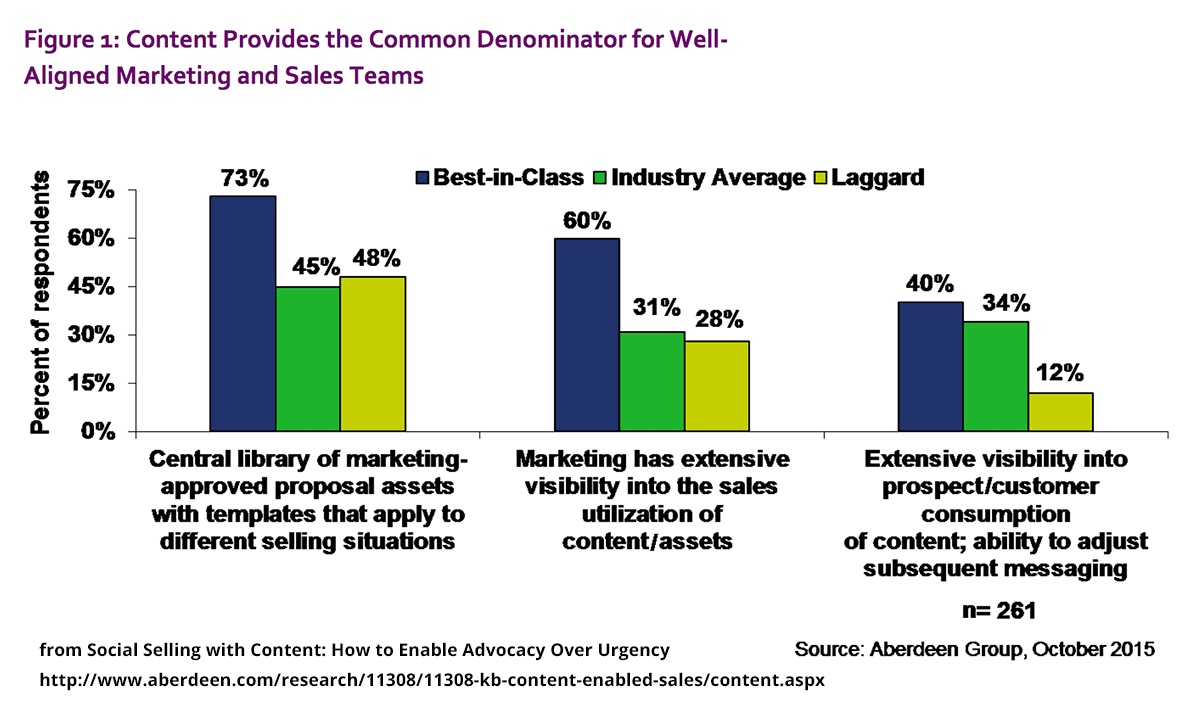 The chart above is from Aberdeen, based on research they did among B2B companies. As you can see, top-performing companies have a vault of pre-approved content to support the sales’ teams social selling work.This pays off in spades. Aberdeen found that “67% of Best-in-Class organizations (the top 20% of respondents in terms of key business metrics) report that they support their sales enablement efforts with content.”To really make your social selling hum, marketing also needs to share what it knows about the buyer’s journey with sales. Specifically, salespeople need to know how many touches they need to have with a prospect before a sale can expect to close. As Aberdeen puts it,
The chart above is from Aberdeen, based on research they did among B2B companies. As you can see, top-performing companies have a vault of pre-approved content to support the sales’ teams social selling work.This pays off in spades. Aberdeen found that “67% of Best-in-Class organizations (the top 20% of respondents in terms of key business metrics) report that they support their sales enablement efforts with content.”To really make your social selling hum, marketing also needs to share what it knows about the buyer’s journey with sales. Specifically, salespeople need to know how many touches they need to have with a prospect before a sale can expect to close. As Aberdeen puts it,
For sales reps to be effective social sellers, they need to know how many interactions it takes, on average, to close a deal, so they can plan out how many sales – and more importantly, non-sales – conversations they need to have with prospects before they’ll be ready to sign on the dotted line. Such non-selling interactions present the ideal opportunity to share knowledge that helps their buyer, as opposed to shallow conversations”.
A few ideas to get your content curation for social selling program started
- Start scouring industry associations and publications for research. Any time you find something good, add it to your curated content vault. Then make a list of your existing prospects who would be interested in this information. Finally, create a distilled version of the research – a one-page or even half page summary (the more visual, the better) and send it along.
- Experiment with the best ways to send the information. Email is the default, but everyone’s inbox is full. Direct mail – or even better, “lumpy mail” is often a better bet. And books are an ideal form of lumpy mail.
- Also experiment with different content formats. We all get so stuck in text that we forget about video or images, or even audio. You could be particularly helpful if you took a thick industry report and made it into a far more consumable content format – like a video.
Mary Meeker’s annual report is a great example. It’s considered a “must read” in many circles, but it’s also nearly 100 pages long. You might get the attention of a lot of your prospects if you distilled Meeker’s report into a five-minute video tailored expressly for their needs and interests.
- Make sure you have an easy-to-use curation software package. Once people really start curating, it helps to have smart software to keep everything organized and easily assessable: like Scoop.it & GaggleAMP are offering in terms of integration.

Conclusion
Buyers are too busy to accept endless voicemails and emails that do nothing to actually help them. And yet, they are hungrier than ever before for useful information. But they simply don’t have time to read every industry publication, every blog post, every webinar, every research study, or even the “must-read” books.But if you are willing to do that, and can curate what you learn for them, suddenly you’re no longer “just a salesperson”. You are instantly an industry expert. A subject authority. Someone who truly can help them.Position yourself like that and see if you don’t get more returned phone calls, emails, and social media messages. And a lot more sales.


